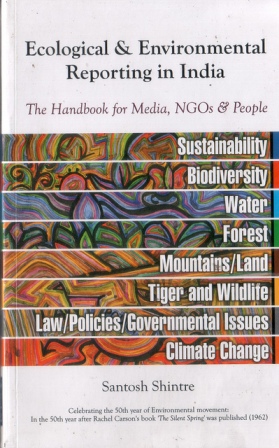Journalism is obviously an imprecise science. As has been pointed out: while science tries to be deliberate, precise and reflective, journalism is fast, imprecise and keen on drama. Yet, what would science be without the public outreach that the media offers? You could say the same for environmentalism, even if the latter is more of a social movement trying to influence the political process by lobbying, activism, and education so as to protect natural resources and ecosystems.
Many younger journalists, including media students, have their heart in the right place. They have a natural inclination towards the environment. But here is the dilemma: how or where do they get started? That’s where Santosh Shintre’s handbook – published in both English and Marathi – steps in.
Even after years of an interest in this arena, one can end up struggling to understand this vast field. Shintre – and his publisher, the Sakal Group of newspapers based in Pune – have done a favour to all those interested in writing on the environment in India by packing voluminous amounts of useful information within a set of reasonably-priced covers.
One is not too sure how many “NGOs and people” will take recourse to this book. Yet, it is certainly a must for every journalist, for every journalism school, and for every newspaper library (high time we had more of these) to stock and frequently refer to.
What makes this book so easy to recommend? Firstly, it has a whole lot of useful information, neatly classified and packaged in an easily digestible manner. Secondly, its focus is primarily India-related, something which a fast-growing media sector (unlike in the Western world) badly needs more of. Its get-up is good, as is its colour printing, and its price.
Pune-based Shintre’s first line in the Preface itself says: “In a country like India with 82,222 newspapers, 312 radio channels, 626 television channels and 700 upcoming FM channels, space and time allotted in the media for coverage of nature and environmental issues is less than 1.5 percent. It is even lesser in the regional media….”
As he points out, over 80 percent of the common people learn about nature and environment-related issues through the print or audio-visual media.
In a situation where the public has high expectations of the media, but the latter is caught up with various constraints and systemic loopholes, the onus is even heavier. Concerned journalists can help to reduce this gap by vaccinating themselves against ignorance.
In 12 succinct chapters, the book takes you through the background you’d need to get started – and do more – in this field. For instance, useful discussions come up in Chapter 2 about a code of ethics for environmental journalists, the skill set they need and an apt comparison between conventional vs investigative journalism. One may not agree every time, but it’s good to have such issues come up for discussion.
Chapter 1 itself starts by listing and briefly explaining the “critical issues” India faces in these fields. Ranging from apathy of citizens and institutions to having a “mistaken model of development”, where the people’s needs hardly feature. One crucial point also is, you guessed right, the negligible coverage of the environment by the Indian media.
Other chapters go more in-depth into sustainability, biodiversity, water, forests, land-based resources, wildlife journalism, laws and governance and climate change, among others. A good enough introduction to a wide range. The 15-page glossary explains terms ranging from abiotics (non-living) to carbon sequestration (long-term storage of carbon in various forms).
Needless to say, no book, however ambitious, can think of itself as complete in all respects. While there’s a good attempt to cover pan-India topics here, a number of local, specific regional subjects are likely to be awaiting coverage. For that, a reader would have to think nationally and apply locally.
A lot of thought has obviously gone into this work. It fills a gap that any editor or journalism-educator would easily admit exists. Now is the time to ensure that it gets adequately noticed and read.
Review by Frederick Noronha
Title: A Handbook of Ecological and Environmental Reporting in India – for the Media, NGOs & People; Author: Santosh Shintre; Publisher: Sakal Papers Ltd.; Pages: 212; Price: Rs.490
The opinions, beliefs and viewpoints expressed by authors, news service providers on this page do not necessarily reflect the opinions, beliefs and viewpoints of Hill Post. Any views or opinions are not intended to malign any religion, ethnic group, club, organization, company, or individual.
Hill Post makes no representations as to the accuracy or completeness of any information on this site page.




